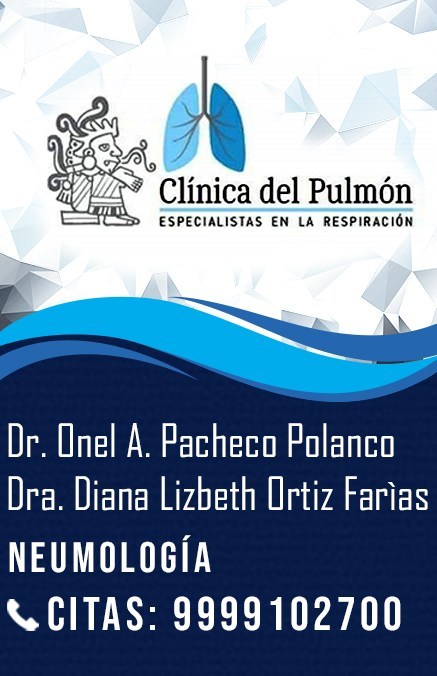The Neumology
It is the branch of medicine that is responsible for the study and medical treatment of diseases that afflict the respiratory and thorax apparatus. These include non-airway suffering (trachea, bronchi and lungs), pleus (membranes that coat the lung), the thoracic box with all its elements (thoracic wall: muscles, ribs, vertebrae). In the same way and with the exception of some organs, the mediastinum (space between both lungs), is also of interest in said specialty. Respiratory and chest diseases can be primary (originated in lungs and thorax itself), or be secondary to systemic diseases (eg, immunological disease, insufficiency of organs such as the heart and kidney, tumors and infections originated in another organ). Diseases most frequently served by the pneumologist are:
COPD
For its acronym in Spanish Chronic obstructive pulmonary disease. Before this disease was divided for study in two entities: chronic bronchitis and pulmonary emphysema. This disease is very frequent in smokers and in those exposed to environmental toxic such as firewood smoke, fumes and powder. Symptoms: chronic cough, phlegm, lack of air, fatigue.
Asthma.
Chronic disease, which appears in episodes and that it is potentially reversible, due to an exaggerated response of the bronchi before an intrinsic or extrinsic stimulus, (p. ahem. cold air, exercise, dust, humidity, some plants, contaminants of the Air, hairs and pet dandruff, mites). SYMPTOMS: Lack of air, wheezing (& ldquo; pillow of the chest “), chronic cough.
Pneumonia.
Pulmonary infection that produces cough with yellow or greenish phlegm, fever, chest pain, general malaise and difficulty breathing. It is presented at any age, but it is more common in elderly people, in which it is usually more severe. In cold weather or when there are changes in temperature is more frequent. Also known as & ldquo; pneumonia “.
Lung cancer.
Malignant lung tumor that is presented in smokers more frequently, although non-smokers it is also observed. It is curable if it is detected in early stages. SYMPTOMS: Chronic cough, inexplained weight loss, lack of air, hemoptysis (phlegm with blood).
Pulmonary tuberculosis.
Chronic infectious disease of the very common lungs in our environment and that of not being treated can lead to great pulmonary destruction and functional disability, risk of infection to family and death. He is currently curable. SYMPTOMS: Chronic cough sometimes very intense, phlegm with or without blood, unexplained weight loss and thinning, fevers, sweats or calosphrists in the evenings or night, lack of slowly progressive air.
Smoking.
Before it was said that it was a habit, however, now it is considered a disease given by nicotine addiction. It is the root of a range of not only respiratory diseases but of all our body, p. Ahem. Lung and breast cancer among others, COPD, heart infarcts, sexual impotence, etc. Currently there is treatment without the need for nicotine.
Other respiratory diseases:
Trabax trauma (p. Ahem. Blows in chest or back by accidents), pulmonary fibrosis, pulmonary mycosis (fungi), rheumatic diseases with pulmonary repercussion (p. ahem. lupus, rheumatoid arthritis), empiema (pus between thelung and ribs), benign tumors, cystic fibrosis, obstructive sleep apnea syndrome (known as Saos and characterized by excessive sleep during the evening day and toning during the night, frequently associated with overweight), acute bronchitis, pleural spills (collectionof liquid in the space between the lung and the ribs called pleural space and having various causes), pneumothorax (abnormal air presence between the lung and ribs that can be of traumatic or spontaneous and inexplicable origin), pulmonary thromboembolism, etc..
The pneumologist is the trained doctor for the diagnosis and treatment of such respiratory diseases, however, currently there is still a public ignorance of this specialty. This situation has contributed in a certain way that the population is looking for and receives medical attention not always qualified or certified for these specific problems, and this in turn, affects the perpetuation or complication of their respiratory conditions.
Another of the scope of the pneumologist is to be able to intervene invasively or not invasively in patients with matters of their specialty. Among the procedures performed by the pneumologist are: Bronchoscopy: Endoscopy study of bronchi mainly for the detection of tumor or infectious lung diseases; Also useful in the extraction of foreign bodies within the bronchi (ahem, pieces of food or fragments of dental prosthesis among others). Spirometry: Non-invasive study that evaluates bronchial function, fundamental for the diagnosis of diseases such as asthma and COPD. Indispensable in smokers, housewives that cook or have cooked with firewood, people who use chlorine or acids for cleaning baths and kitchens at home or work, or those workers with exposure to powders, gases or fumes (ahem . Construction workers, workers of petrochemical plants, stylists, chefs, etc.), it is also useful in monitoring sequelae of chronic respiratory diseases or for the assessment of lung function prior to surgeries in general. Lung biopsies and / or pleura: Sample sample of pulmonary or pleural tissue for the diagnosis of diseases such as cancer or severe infections. TORACOcentesis: Extraction of pleural fluids for diagnostic purposes or as part of the treatment (p. Ahem. Pleural spill in patients with renal failure that does not respond to medications or dialysis, or patients with malignant diseases).





